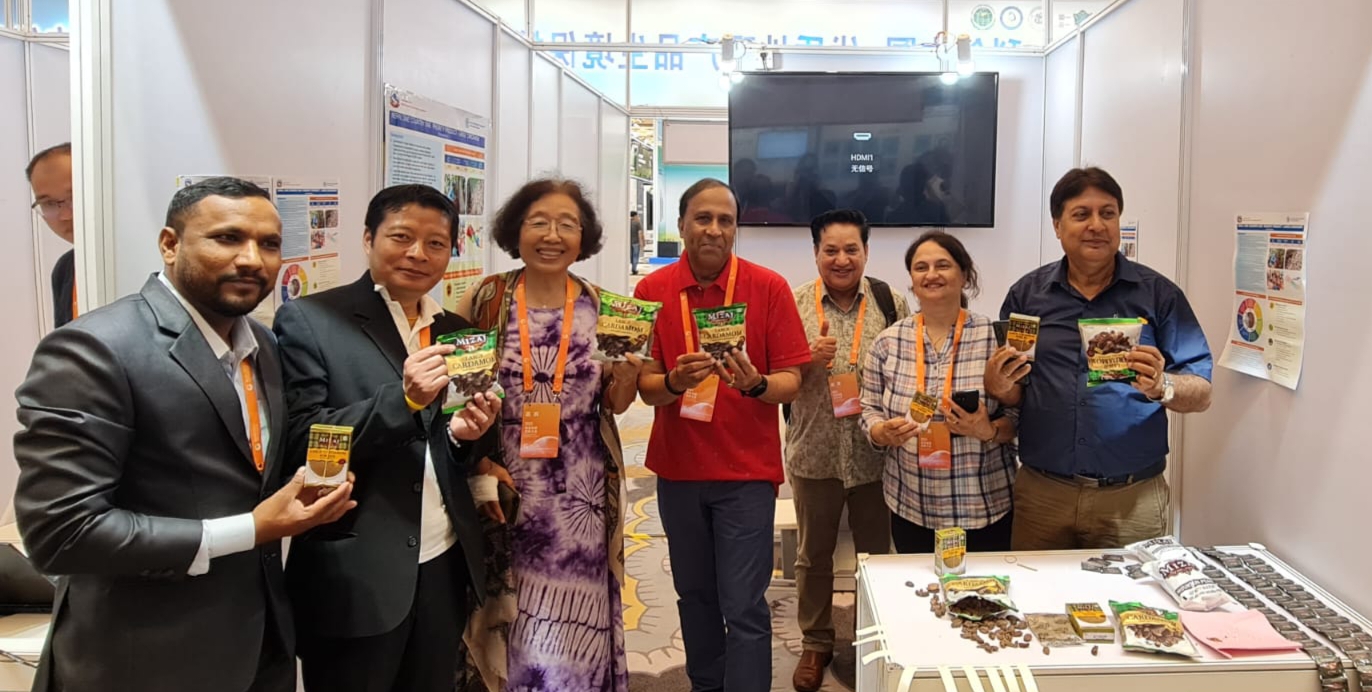Green Agriculture Forum: Geographical Indications Environment and Sustainability for OCOP implementation in the Asia-Pacific Region

(left) Presentation by Ms Sabnam Shivakoti, Joint Secretary, Government focal for National TCP on OCOP, MOALD on behalf of Nepal team. (right) Presentation by Ms Kuenzang Om, Department of Agriculture, MOAL, Bhutan on behalf of Bhutan team.
©©FAO/Xuan Li (right) ©IGSNRR/CAS / Chuang Liu (left)
Huzhou, China, 14-16 August 2023 - On 15 August the first National Ecological Day in China, more than 100 participants, including representatives from Bangladesh, Bhutan, Cambodia, Nepal and Papua New Guinea, had gathered in Huzhou, China, a beautiful place, on the occasion of the “China Green Low Carbon Innovation Conference (GLCC)” that was co-organized by the Chinese Association for Science and Technology, Ministry of Housing and Urban-Rural Developagment, and the Government of Zhejiang Province of China, to learn about Green Agriculture and GIES and OCOP in China, and present their own experiences.
Dr Hui Luo, Director-General of the International Cooperation Department of IGSNRR/CAS, Prof. Shenglin Wang, Deputy Director of IGSNRR/CAS, Prof. Guoyou Zhang, Vice President and Secretary General of Geographical Society of China extended warm welcoming remarks. The Workshop was opened by Prof. Xiaohan Liao, Team Leader of GIES IGSNRR/CAS and Dr Xuan Li, Regional OCOP Coordinator in FAO RAP, on behalf of the co-organizers of the Workshop.
Dr Changchui He, former Deputy Director-General of FAO delivered a keynote speech ‘Promoting Smart and Green Agriculture and Food System Transformation in Support of UN SDG’. Prof Chuang Liu, Prof of IGSNRR/CAS and Vice Chair of the Regional Organizing Group of FAO OCOP in Asia and the Pacific and an untiring promoter of unique agricultural products, expanded on the topic of GIES methodology and Technology Transfer for OCOP implementation. Prof. Ke Gong, Chairman of China University Union on Ecosystem Education and Former President of World Federation of Engineering Organization (WFEO), presented how GIES and ecosystem help China’s higher education in universities.
Participants then exchanged their experiences: GIES cases from China as well as from OCOP countries (Bangladesh/jackfruit, Bhutan/quinoa, Cambodia/mango, Nepal/large cardamom, Papua New Guinea/vanilla) were presented and discussed. Of special interest were presentations by Mr Yizhen Han, Deputy Mayor of Feng County, Zhejiang Province and Mrs. Lei Zhou, Yucheng, Shandong Province, on how modern technology of GIES had empowered the local small-holder farmers incentive by rapid revenues generated from their local SAPs which stimulated strong incentives to preserve environment.
 Prof. Kadambot Siddique and Bangladesh
OCOP team on Jackfruit at the GIES and OCOP exhibition in Huzhou,
Zhejiang, China. © FAO/Xuan Li
Prof. Kadambot Siddique and Bangladesh
OCOP team on Jackfruit at the GIES and OCOP exhibition in Huzhou,
Zhejiang, China. © FAO/Xuan Li
The sessions continued with an introduction to Conservation Agriculture as a response to Climate Change by Professor Prof Kadambot H.M. Siddique, Director and Professor of Western Australia Agricultural Research Institute, Fellow of the Australian Academy of Science, and Special Ambassador of FAO for the International Year of Pulses, and concluded with a ‘Next Generation Session’: young middle school students (aged 11 to 16) presented their views on the future of agriculture and the ecology.
 Prof. Chuang Liu, Prof. Kadambot Siddique and Nepal OCOP team on Large
Cardamom at the GIES and OCOP exhibition in Huzhou, Zhejiang, China.
©FAO/Xuan Li
Prof. Chuang Liu, Prof. Kadambot Siddique and Nepal OCOP team on Large
Cardamom at the GIES and OCOP exhibition in Huzhou, Zhejiang, China.
©FAO/Xuan Li
The following day, Chinese GIES as well as OCOP presenters provided samples of their products in Taihu Longemont Convention Center. The Chinese GIES cases include Dry Grassland in Yanchitan; Dry-hot Valley Baoshan Coffee, Xinzhai Village; Permanent Basic Farmland in Panshi Lanjia Village; Burdock Ancient Yellow River Flooding Area in Fengxian County; Crested Ibis Habitat and Black Rice in Caoba Village; Splendid Begonia in Low Mountains and Hills of Baoshan, Panshi; Fish Fishing in Summer and Winter in Panshi Qiantang; Subtropical Low Mountains and Hills in Jiangpu, Lizhi, Conghua; Yellow River Diversion Irrigation Area with Wheat and Grain Twice Ripe in Fangsi, Yucheng; Yellow Millet/Danchuan Millet in Red Clay area of Gaodu Town, Zezhou; Panshi Large Corylus Futai Township in Low Mountain and Hills; Panshi Rice Qiantang Case in Permanent Farmland; Suining Sweet Potato Qingfeng Village Case in Subtropical Hills; Korla Fragrant Pear in Kongque River Oasis; Fengxian Crispy Pear in ancient Yellow River Flood-Plain areas; Fengxian Apple in Yellow River Route; Lipu Taro-Rice Crop Rotation in Permanent Farmland.
All 17 GIES cases in China as well as five OCOP cases (Bangladesh Jackfruit; Bhutan Quinoa in alpine plateau habitat; Cambodia Mango; Nepal Large Cardamom in alpine plateau habitat; Papua New Guinea Vanilla) were present and surrounded by visitors.
